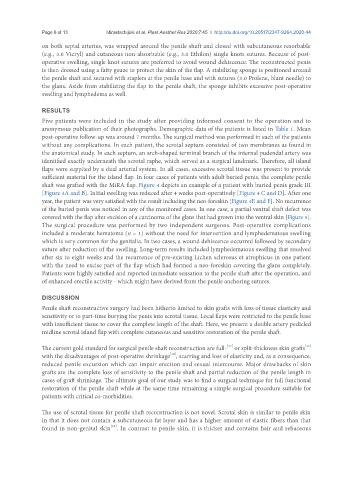Page 509 - Read Online
P. 509
Page 8 of 13 Mirastschijski et al. Plast Aesthet Res 2020;7:45 I http://dx.doi.org/10.20517/2347-9264.2020.44
on both septal arteries, was wrapped around the penile shaft and closed with subcutaneous resorbable
(e.g., 3.0 Vicryl) and cutaneous non-absorbable (e.g., 3.0 Ethilon) single knots sutures. Because of post-
operative swelling, single knot sutures are preferred to avoid wound dehiscence. The reconstructed penis
is then dressed using a fatty gauze to protect the skin of the flap. A stabilizing sponge is positioned around
the penile shaft and secured with staplers at the penile base and with sutures (3.0 Prolene, blunt needle) to
the glans. Aside from stabilizing the flap to the penile shaft, the sponge inhibits excessive post-operative
swelling and lymphedema as well.
RESULTS
Five patients were included in the study after providing informed consent to the operation and to
anonymous publication of their photographs. Demographic data of the patients is listed in Table 1. Mean
post-operative follow-up was around 7 months. The surgical method was performed in each of the patients
without any complications. In each patient, the scrotal septum consisted of two membranes as found in
the anatomical study. In each septum, an arch-shaped terminal branch of the internal pudendal artery was
identified exactly underneath the scrotal raphe, which served as a surgical landmark. Therefore, all island
flaps were supplied by a dual arterial system. In all cases, excessive scrotal tissue was present to provide
sufficient material for the island flap. In four cases of patients with adult buried penis, the complete penile
shaft was grafted with the MiRA flap. Figure 4 depicts an example of a patient with buried penis grade III
[Figure 4A and B]. Initial swelling was reduced after 4 weeks post-operatively [Figure 4 C and D]. After one
year, the patient was very satisfied with the result including the neo-foreskin [Figure 4E and F]. No recurrence
of the buried penis was noticed in any of the monitored cases. In one case, a partial ventral shaft defect was
covered with the flap after excision of a carcinoma of the glans that had grown into the ventral skin [Figure 5].
The surgical procedure was performed by two independent surgeons. Post-operative complications
included a moderate hematoma (n = 1) without the need for intervention and lymphedematous swelling
which is very common for the genitalia. In two cases, a wound dehiscence occurred followed by secondary
suture after reduction of the swelling. Long-term results included lymphedematous swelling that resolved
after six to eight weeks and the recurrence of pre-existing Lichen sclerosus et atrophicus in one patient
with the need to excise part of the flap which had formed a neo-foreskin covering the glans completely.
Patients were highly satisfied and reported immediate sensation to the penile shaft after the operation, and
of enhanced erectile activity - which might have derived from the penile anchoring sutures.
DISCUSSION
Penile shaft reconstructive surgery had been hitherto limited to skin grafts with loss of tissue elasticity and
sensitivity or to part-time burying the penis into scrotal tissue. Local flaps were restricted to the penile base
with insufficient tissue to cover the complete length of the shaft. Here, we present a double artery pedicled
midline scrotal island flap with complete cutaneous and sensitive restoration of the penile shaft.
[17]
[12]
The current gold standard for surgical penile shaft reconstruction are full- or split-thickness skin grafts
[10]
with the disadvantages of post-operative shrinkage , scarring and loss of elasticity and, as a consequence,
reduced penile excursion which can impair erection and sexual intercourse. Major drawbacks of skin
grafts are the complete loss of sensitivity to the penile shaft and partial reduction of the penile length in
cases of graft shrinkage. The ultimate goal of our study was to find a surgical technique for full functional
restoration of the penile shaft while at the same time remaining a simple surgical procedure suitable for
patients with critical co-morbidities.
The use of scrotal tissue for penile shaft reconstruction is not novel. Scrotal skin is similar to penile skin
in that it does not contain a subcutaneous fat layer and has a higher amount of elastic fibers than that
found in non-genital skin . In contrast to penile skin, it is thicker and contains hair and sebaceous
[19]

